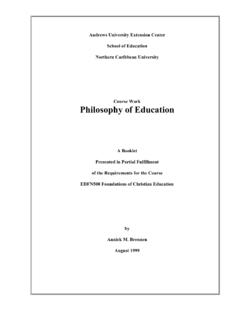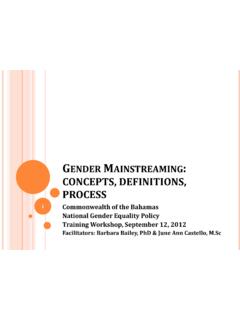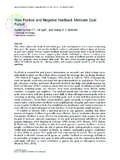Transcription of The Superintendent Administrator Com petencies - Bahamas
1 SuperintendentAdministrator CompetenciesThe AASA Professional Standards for the Superintendency are listed and District Culture. Demonstrate executive leadership by developinga collective district vision; shape school culture and climate; provide purpose anddirection for individuals and groups; demonstrate an understanding of internationalissues affecting education; formulate strategic plans, goals, and change efforts withstaff and community; set priorities in the context of community, student and staffneeds; serve as an articulate spokesperson for the welfare of all students in amulticultural : A Superintendent should know and be able to: Formulate a written vision statement of future direction for the district. Demonstrate an awareness of international issues affecting schools and students.
2 Promote academic rigor and excellence for staff and students. Maintain personal, physical, and emotional wellness. Empower others to reach high levels of performance. Build self-esteem in staff and students. Exhibit creative problem solving. Promote and model risk taking. Respect and encourage diversity among people and programs. Manage time effectively. Facilitate comparative planning between constituencies. Conduct district school climate assessments. Exhibit multicultural and ethnic understanding. Promote the value of understanding and celebrating school/community and governance. Develop procedures for working with the board of educationthat define mutual expressions, working relationships, and strategies for formulatingdistrict policy for external and internal programs; adjust local policy to state andfederal requirements and constitutional provisions, standards, and regulatoryapplications; recognize and apply standards involving civil and criminal : A Superintendent should know and be able to: Describe the system of public school governance in our democracy.
3 Describe procedures for Superintendent /board of education interpersonal andworking relationships. Formulate a district policy for external and internal programs. Relate local policy to state and federal regulations and requirements. Describe procedures to avoid civil and criminal and Community Relations. Articulate district purpose andpriorities to the community and mass media; request and respond to communityfeedback; and demonstrate consensus building and conflict mediation. Identify,track, and deal with issues. Formulate and carry out plans for internal and externalcommunications. Exhibit an understanding of school districts as political systemsby applying communication skills to strengthen community support; alignconstituencies in support of district priorities; build coalitions to gain financial andprogrammatic support; formulate democratic strategies for referenda; relate politicalinitiatives to the welfare of : A Superintendent should know and be able to: Articulate district vision, mission, and priorities to the community and mass media.
4 Demonstrate an understanding of political theory and skills needed to buildcommunity support for district priorities. Understand and be able to communicate with all cultural groups in the community. Demonstrate that good judgment and actions communicate a well as words. Develop formal and informal techniques to gain external perception of a district bymeans of surveys, advisory groups, and personal contact. Communicate and project and articulate position for education. Write and speak clearly and forcefully. Demonstrate formal and informal listening skills. Demonstrate group membership and leadership skills. identify the political forces in a community. Identify the political context of te community environment. Formulate strategies for passing referenda. Persuade the community to adopt an initiative for the welfare of students.
5 Demonstrate conflict mediation. Demonstrate consensus building. Demonstrate school/community relations, school business partnerships, and relatedpublic service activities. Identify, track, and deal with issues. Develop and carry out internal and external communication Management. Exhibit an understanding of the school district as asystem by defining processes for gathering, analyzing, and using data for decisionmaking; manage the data flow; frame and solve problems; frame and developpriorities and formulate solutions; assist others to form reasoned opinions; reachlogical conclusions and make quality decisions to meet internal and externalcustomer expectations; plan and schedule personal and organization work; establishprocedures to regulate activities and projects; delegate and empower at appropriateorganizational levels; secure and allocate human and material resources; develop andmanage the district budget.
6 Maintain accurate fiscal : A Superintendent should know and be able to: Define processes for gathering, analyzing, and using data to inform decision making. Demonstrate a problem framing Define the major components of quality management. Develop, implement, and monitor change processes to build capacities and serveclients. Discuss legal concepts, regulations, and codes for school operations. Develop a process for maintaining accurate fiscal reporting. Acquire, allocate, and manage human, material, and financial resources effectivelyand accountably ensure successful student learning. Use technological applications to enhance administration of business and supportsystems. Demonstrate financial forecasting, planning, and cash flow management. Perform budget planning, management, account auditing, and monitoring.
7 Demonstrate a grasp of practices in administering auxiliary programs such asmaintenance, facilities, food services, etc. Demonstrate planning and scheduling of personal time and organization Planning and Development. Design curriculum and a strategic planthat enhance teaching and learning in multiple contexts; provide planning and futuremethods to anticipate occupational trends and their educational implications; identifytaxonomies of instructional objectives and validate procedures for curricular units,using theories of cognitive development; align sequence curriculum; use valid andreliable performance indicators and test procedures to measure performanceoutcomes; and describe the proper use of computers and other learning andinformation : A Superintendent should know and be able to: Develop core curriculum design and delivery systems for diverse school communities.
8 Describe curriculum planning/futures methods to anticipate occupational trends andtheir educational implications for lifelong learners. Demonstrate an understanding of instructional taxonomies, goals, objectives, andprocesses. Describe cognitive development and learning theories and their importance in thesequencing of instruction. Demonstrate an understanding of child and adolescent growth and development. Describe a process to create developmentally appropriate curriculum andinstructional practices for all children and adolescents. Demonstrate the use of computers and other technologies in educationalprogramming. Conduct assessments of present and future student learning needs. Develop a process for faculty input in continued and systematic renewal of thecurriculum to ensure appropriate scope, sequence, and content.
9 Demonstrate an understanding of curricular alignment to ensure improved studentperformance and hither order Management. Exhibit knowledge of instructional management byimplementing a system that includes research findings on learning and instructionalstrategies, instructional time, advanced electronic technologies, and resources tomaximize student outcomes; describe and apply research and best practice curriculum and resources for multicultural sensitivity and assessmentstrategies, instructional time, advanced electronic technologies, and resources tomaximize student outcomes; describe and apply research and best practice onintegrating curriculum and resources for multicultural sensitivity and assessmentstrategies to help students achieve at high : A Superintendent should know and be able to: Develop, implement, and monitor change processes to improve student learning,adult development, and climates for learning.
10 Demonstrate an understanding of motivation in the instructional process. Describe classroom management theories and techniques. Demonstrate an understanding of the development of the total student, including thephysical, social, emotional, cognitive, and linguistic needs. Formulate a plan to assess appropriate teaching methods and strategies for alllearners. Analyze available instructional resources and assign them in the most cost-effectiveand equitable manner to enhance student outcomes. Describe instructional strategies that include the role of multicultural sensitivity andlearning styles. Exhibit applications of computer technology connected to instructional programs. Describe alternative methods of monitoring and evaluating student achievementbased on objectives and learning outcomes.






